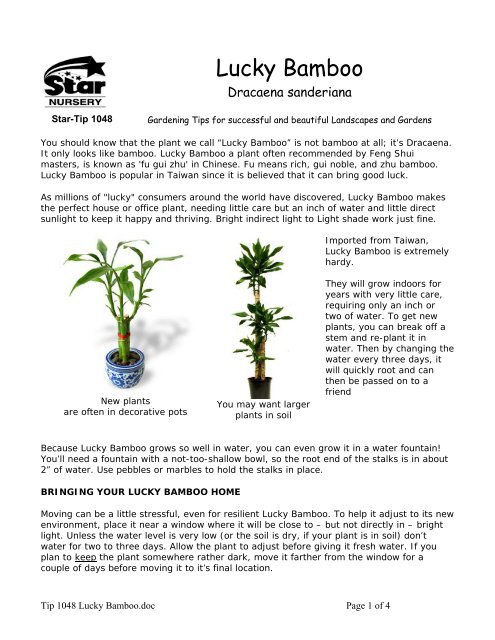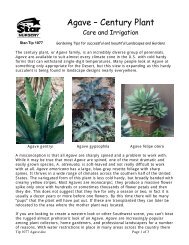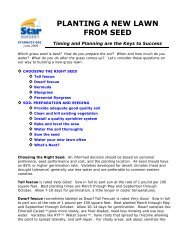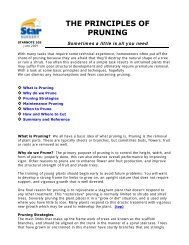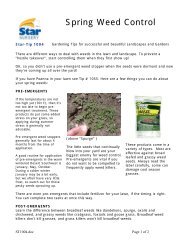Dracaena sanderiana - Lucky bamboo - Star Nursery
Dracaena sanderiana - Lucky bamboo - Star Nursery
Dracaena sanderiana - Lucky bamboo - Star Nursery
- No tags were found...
You also want an ePaper? Increase the reach of your titles
YUMPU automatically turns print PDFs into web optimized ePapers that Google loves.
<strong>Lucky</strong> Bamboo<br />
<strong>Dracaena</strong> <strong>sanderiana</strong><br />
<strong>Star</strong>-Tip 1048<br />
Gardening Tips for successful and beautiful Landscapes and Gardens<br />
You should know that the plant we call “<strong>Lucky</strong> Bamboo” is not <strong>bamboo</strong> at all; it’s <strong>Dracaena</strong>.<br />
It only looks like <strong>bamboo</strong>. <strong>Lucky</strong> Bamboo a plant often recommended by Feng Shui<br />
masters, is known as 'fu gui zhu' in Chinese. Fu means rich, gui noble, and zhu <strong>bamboo</strong>.<br />
<strong>Lucky</strong> Bamboo is popular in Taiwan since it is believed that it can bring good luck.<br />
As millions of "lucky" consumers around the world have discovered, <strong>Lucky</strong> Bamboo makes<br />
the perfect house or office plant, needing little care but an inch of water and little direct<br />
sunlight to keep it happy and thriving. Bright indirect light to Light shade work just fine.<br />
Imported from Taiwan,<br />
<strong>Lucky</strong> Bamboo is extremely<br />
hardy.<br />
New plants<br />
are often in decorative pots<br />
You may want larger<br />
plants in soil<br />
They will grow indoors for<br />
years with very little care,<br />
requiring only an inch or<br />
two of water. To get new<br />
plants, you can break off a<br />
stem and re-plant it in<br />
water. Then by changing the<br />
water every three days, it<br />
will quickly root and can<br />
then be passed on to a<br />
friend<br />
Because <strong>Lucky</strong> Bamboo grows so well in water, you can even grow it in a water fountain!<br />
You’ll need a fountain with a not-too-shallow bowl, so the root end of the stalks is in about<br />
2” of water. Use pebbles or marbles to hold the stalks in place.<br />
BRINGING YOUR LUCKY BAMBOO HOME<br />
Moving can be a little stressful, even for resilient <strong>Lucky</strong> Bamboo. To help it adjust to its new<br />
environment, place it near a window where it will be close to – but not directly in – bright<br />
light. Unless the water level is very low (or the soil is dry, if your plant is in soil) don’t<br />
water for two to three days. Allow the plant to adjust before giving it fresh water. If you<br />
plan to keep the plant somewhere rather dark, move it farther from the window for a<br />
couple of days before moving it to it’s final location.<br />
Tip 1048 <strong>Lucky</strong> Bamboo.doc Page 1 of 4
WHERE TO KEEP IT<br />
<strong>Lucky</strong> Bamboo can be poisonous to pets. If you have pets in the house, especially pets who<br />
like to chew on plants, you’ll want to keep it where these pets won’t get at it. This may<br />
mean getting a smaller plant that will fit on a high shelf, rather than splurging on a large<br />
arrangement for your living room coffee table.<br />
It is a very easy plant to have almost anywhere in the house from shady to bright rooms.<br />
The canes when old lose the smooth light green surface and begin to develop an attractive<br />
light brown paper like 'bark'.<br />
Other practical considerations include making sure the plants will not be in much direct<br />
sunlight, and that they won’t get too dry or too cold. In other words, avoid putting your<br />
<strong>Lucky</strong> Bamboo arrangement right in front of the heating or A/C vent or on your sunniest<br />
windowsill. While need to avoid these extremes, <strong>Lucky</strong> Bamboo will do fine just about<br />
anywhere else. Since <strong>Lucky</strong> Bamboo can tolerate a wide range of living conditions, you<br />
have a lot of flexibility about where to display it.<br />
CARING FOR YOUR LUCKY BAMBOO<br />
Like any other plant, <strong>Lucky</strong> Bamboo does need some light. It of course needs water, and<br />
nutrients to survive. It will do better with little attention than if you fuss over it, however.<br />
This plant likes to be admired but not pampered. Here are some guidelines to help you give<br />
it the best care:<br />
Light & Temperature: <strong>Lucky</strong> Bamboo will do best with moderate levels of indirect light.<br />
Sustained direct sunlight is too strong. It will tolerate low level light more easily than too<br />
much light. If you want your <strong>Lucky</strong> Bamboo to grow, however, it will need to be at the<br />
higher end of its light-range. It may survive very low light, but it won’t put out new leaves<br />
or get any taller. <strong>Lucky</strong> Bamboo prefers room temperatures at 65-70 o .<br />
Water: <strong>Lucky</strong> Bamboo grows very well hydroponically with its roots submerged in water,<br />
but it doesn’t like the chemicals – chlorine and fluoride, to name just two – present in most<br />
tap water, or salts that are quite high in Las Vegas water. Filtered water or rain water will<br />
keep your <strong>Lucky</strong> Bamboo healthy longer. If you don’t have a water filtration system, plan<br />
ahead and run tap water into a container the day before you water your <strong>Lucky</strong> Bamboo<br />
plants, and let it sit out, uncovered, at least overnight or for 24 hours to allow the<br />
chemicals to disperse. If you use distilled or reverse osmosis water, use a small amount of<br />
Dr. Q’s Plant tonic to reinstate the necessary minerals for plant health.<br />
Keep an eye on the water level in your <strong>Lucky</strong> Bamboo container, and add a little more as it<br />
gets lower; how often will depend on the size of your arrangement and the humidity in your<br />
home. Keep the water level at approximately an inch from the base of the canes. Every<br />
week or so, pour all the water out and refill the container with fresh water.<br />
If you happen to have a fresh water aquarium in your home, save some of the dirty<br />
aquarium water when you clean it, and use that to water your <strong>Lucky</strong> Bamboo. Your fish<br />
may be sensitive to all the microscopic stuff that builds up in the water, but your <strong>Lucky</strong><br />
Bamboo will love it! DO NOT USE SALT WATER!<br />
Tip 1048 <strong>Lucky</strong> Bamboo.doc Page 2 of 4
HUMIDITY: Routine misting of your <strong>Lucky</strong> Bamboo may be necessary if you live in a dry<br />
climate. Read troubleshooting tips for symptoms of dryness.<br />
NUTRIENTS: <strong>Lucky</strong> Bamboo is pretty hardy, but it needs modest amounts of macro and<br />
micro nutrients occasionally. If it gets spindly and pale, try moving it a little closer to a light<br />
source and give it several drops of Plant Tonic. However, if it turns yellow shortly after you<br />
bring it home that’s often a sign it was over-fertilized before you purchased it. Change the<br />
water immediately, and don’t fertilize at all for several months.<br />
The best time to feed your <strong>Lucky</strong> Bamboo is when you change the water. Just add a couple<br />
of drops of Plant Tonic to the water you use to refill the container. If your <strong>Lucky</strong> Bamboo is<br />
growing in soil, you can use a stronger solution (1/2 teaspoon diluted in a quart of good<br />
water).<br />
Don’t feed every time you change the water! Every 2 months—or longer-- is often enough.<br />
Water-grown plants do not need to be fed as frequently as soil-grown plants, and feeding<br />
too much or too frequently is more harmful to plants than not feeding enough! <strong>Lucky</strong><br />
Bamboo is naturally a very slow-growing plant, so don’t assume it needs to be fed just<br />
because it doesn’t seem to be growing.<br />
SHAPING YOUR PLANT <strong>Lucky</strong> Bamboo stalks are naturally straight. If you want curls, you<br />
have to encourage them by manipulating the plant’s position relative to its light source.<br />
You’ll want to place your plant where there is not much overall light, but with a strong light<br />
source from one side (avoid too much direct sunlight!).<br />
Try cutting the end and one side from a cardboard box, and set it over the entire thing so<br />
the open side is toward a window and the other three sides and top are shaded. After a<br />
while, you’ll notice that the stalks are starting to turn or bend toward the light. Once a<br />
definite bend to the stalk can be seen, turn the plant slightly by rotating the pot an inch or<br />
so. The plant will keep growing toward the light, and if you keep rotating the pot from time<br />
to time eventually you will have a spiraling stalk. Be patient, this process can take time.<br />
TROUBLESHOOTING<br />
In case your plant needs some extra attention here are some signs of trouble and what you<br />
should do if you see them:<br />
- Leaf tips turning brown: fluoride or salts in the water, or the air is too dry. Try switching<br />
to distilled or filtered water if you’ve been using tap water. If you’ve been using fertilizer a<br />
little too often, change the water and skip the plant food for several months. Low humidity<br />
can also cause the leaf tips to turn brown; remember that this is a tropical plant, so it likes<br />
high humidity. Don’t over water the plant (if in soil); it’s the leaf tips that are drying out,<br />
not the roots. Fill a plastic squirt-bottle with water and mist the leaves every day to keep<br />
them healthy.<br />
- Leaves turning yellow: too much light or too much fertilizer. Change the water<br />
immediately, move the container further from the light, and don’t feed at all for several<br />
months.<br />
Tip 1048 <strong>Lucky</strong> Bamboo.doc Page 3 of 4
- Stalks turning yellow from the bottom: too much fertilizer. Change the water and don’t<br />
feed, and there’s a chance the plant may recover. You can also cut off the stalks above the<br />
yellow part and root the tops. If one stalk turns yellow and the others look fine, just<br />
remove that one from the arrangement.<br />
- Stalks turn brown or mushy: the roots have rotted, probably from overfeeding, or from<br />
over-watering soil-grown plants. You CAN NOT save the bottom, but you can cut off<br />
healthy tops and restart them.<br />
- Insects or larvae in the water, or white sticky-looking stuff on the stalks: remove the<br />
stalks from the container and soak them in soapy water (Dove is fine, a few drops is<br />
enough), then wipe each stalk and rinse well. Wash out the container and the rocks or<br />
marbles, and then replace the stalks and add fresh water.<br />
- Algae growing in the water: too much light and/or fertilizer. An opaque container is better<br />
if you are using plant food. Wash everything (plant stalks, container, rocks) and start over<br />
with clean water. Keep glass containers away from bright locations.<br />
IF THE STALKS GET TOO TALL<br />
Your <strong>Lucky</strong> <strong>bamboo</strong> may grow to be three feet tall. It likes to be crowded, so don’t be in a<br />
hurry to move your arrangement into a bigger pot. <strong>Lucky</strong> Bamboo grows tall rather than<br />
wide. When it does get too tall, you can cut off each stalk an inch above one of the nodes<br />
(the rings around the stalk), and it will restart from there. Lightly misting the tops of the<br />
stalks with water can encourage new growth – but wait a few days before doing this, so the<br />
cut surface can dry out first.<br />
POTTING UP<br />
Although <strong>Lucky</strong> Bamboo grows well in water, you may decide you’d like to grow yours in<br />
soil. If your <strong>Lucky</strong> Bamboo has been growing in water for a long time, it may not survive<br />
the transition to soil unless you keep it quite moist until the roots have adapted. Use a soil<br />
mixture that drains well. Make sure the pot has holes in the bottom, and use rocks or<br />
similar media in the bottom to assure uniform drainage. If the soil does not drain well, the<br />
roots can rot and the plant will suffer or die. Use a container that’s no more than about 2”<br />
larger than the stalk group.<br />
<strong>Lucky</strong> Bamboo grown in soil should be keep slightly moist, not soaking wet. Don’t allow it<br />
to dry out completely. Use a moisture meter to determine when to water, don’t let the<br />
surface fool you. Often the soil will still be damp a half-inch or so below the surface.<br />
© 2009, <strong>Star</strong> <strong>Nursery</strong>, Inc. Copy Provided courtesy of <strong>Star</strong> <strong>Nursery</strong><br />
www.<strong>Star</strong><strong>Nursery</strong>.com<br />
Tip 1048 <strong>Lucky</strong> Bamboo.doc Page 4 of 4


